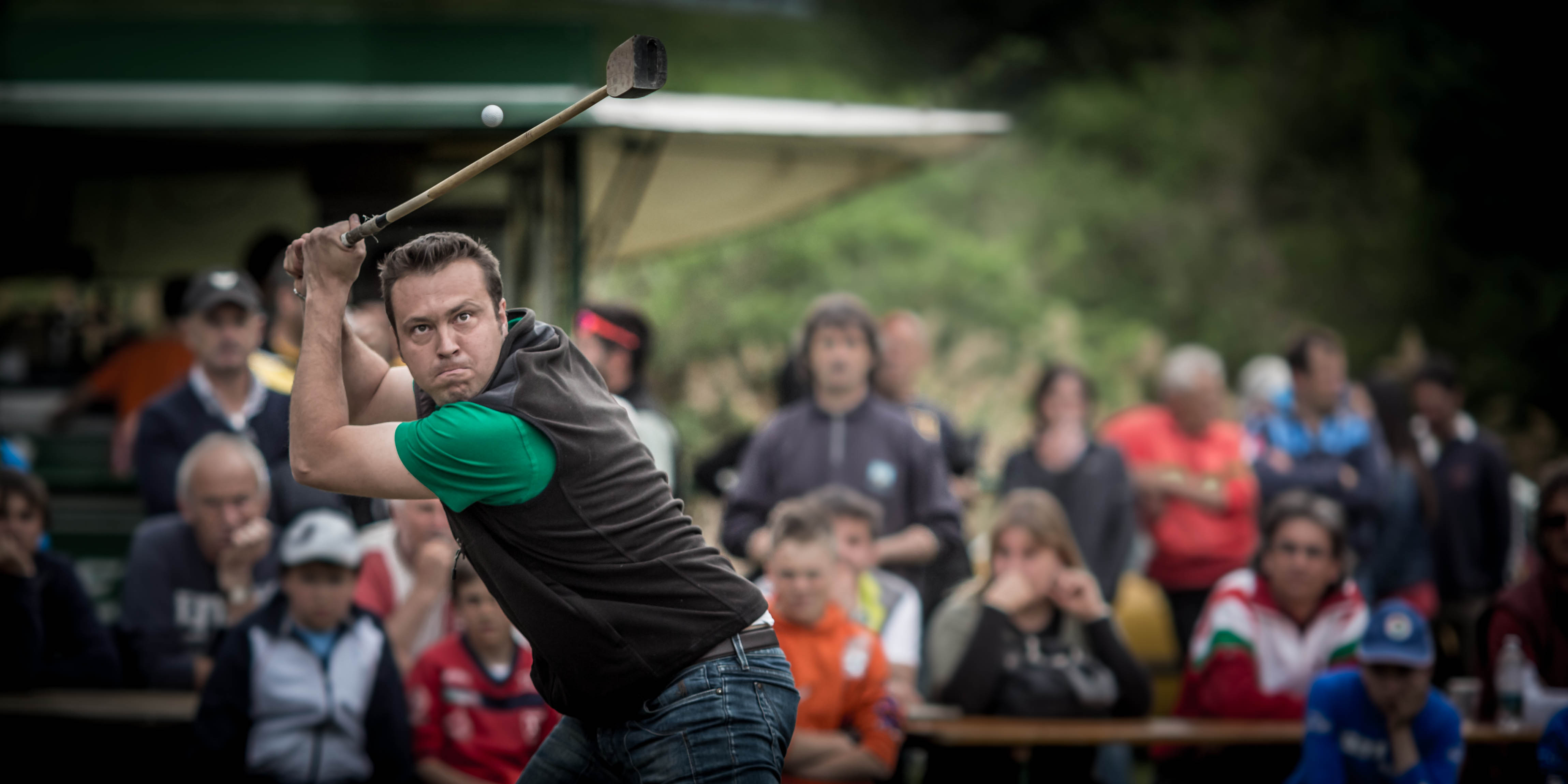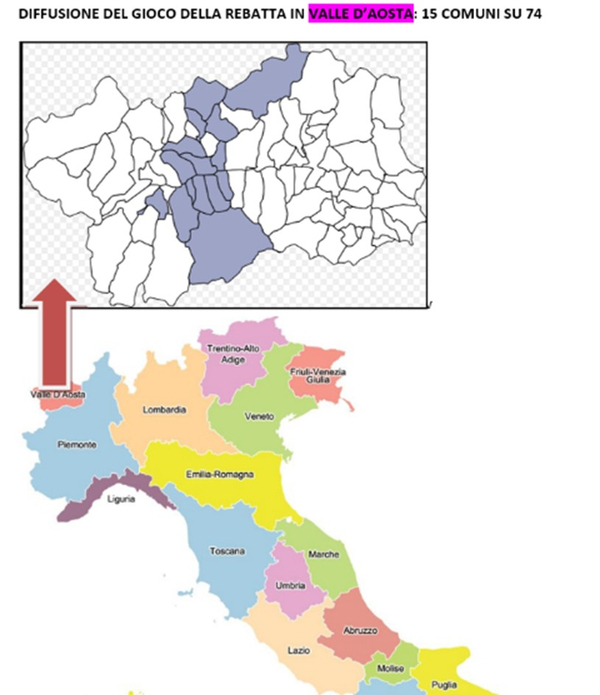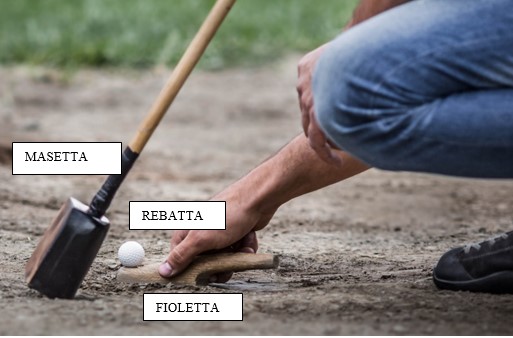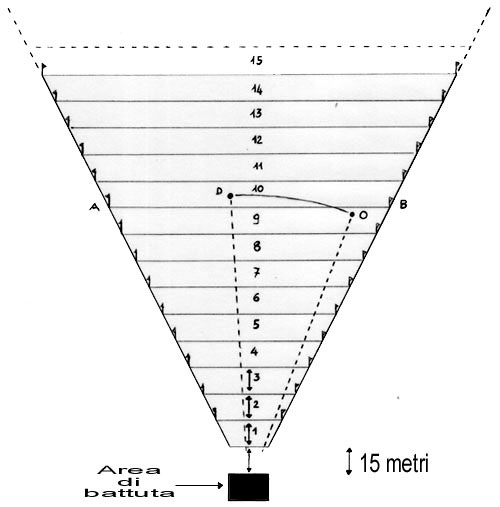
Rebatta (Italy)
- Name of sport (game): Rebatta
- Name in native language: rebatta
- Place of practice (continent, state, nation):
Valle d'Aosta, Italy
Sections of the Valdostana Rebatta Association coincide with the municipalities of residence of the players and de facto indicate the territory in which the game is officially practiced and in which the championships are held. The sections adhering to the Association are: Aosta, Aymavilles, Bionaz, Charvensod, Chevrot, Cogne, Doues, Gignod, Gressan, Introd, Ollomont, Pollein, Saint-Christophe, Sarre, Valpelline.

- History:
Rebatta, a traditional Aosta Valley game, belongs to the large family of bat-ball throwing games. Golf and baseball are the best known relatives but similar recreational and sporting practices are numerous throughout the world.
According to a thesis by prof. Pierino Daudry, based on the studies of the ethnologist Arnold Van Gennep, disciplines such as rebatta are the evolution of ancient agro-pastoral rituals transformed over the centuries into traditional games until they became sports with real regulations.
The practice of this game is recognized by direct testimonies already in the second half of the 19th century in the Aosta area and in the Coumba Freide. Likewise, the spread of similar games is known in the valleys of Cogne, Champorcher and Valtournenche (tsanfolla).
The game was played to win "the hand", that is, the sum of the points scored by the team members for a single innings. To win the challenge you had to win a pre-established number of "hands".
The value of a single measure was counted in steps, which frequently generated discussions.
Later we moved on to calculate a point every 15 steps and to delimit a primitive regulated playing field.
After the Second World War, the seed began that would lead to the transformation of a rural ludo practice into a sporting activity.
The first competitions are organized, the players refine their technique with the first training sessions and the rudimentary equipment becomes increasingly refined. - Description:
Let's first define what the typical tools of this sport are and their functions.
The “Rebatta”: it is a ball with a diameter of 30 mm; it is made of wood (in this case weighed down by an integral covering made with metal nails planted in the wood) or metal.
The "Fioletta": is a pipe-shaped wooden instrument, about 20 cm long, with a lever function. The "rebatta" is placed on the slightly hollowed end in contact with the ground; the other end is struck from the "masetta" to project the ball into the air.
The "Masetta": is a wooden club 100 - 140 cm long, which ends with a solid wood "head"; the bat is called "baton", the head "maciocca".
Having placed the "fioletta" on the ground, the player places the "rebatta" at one end. Having held the "masetta" with both hands, he touches the nozzle of the "fioletta" projecting the ball into the air (action defined as "levoù") to hit it on the fly and throw it as far as possible.
The playing field is an isosceles triangle with the vertex located at the center of the serving area (called "place"), a rectangle of at least three meters by two. The height of the triangle represents the theoretical throwing line, the length and orientation of the field, it varies depending on the categories: from 180 to 240 meters. Inside it, lines are drawn with ropes at a distance of 15 meters , which determine the attribution of points for each throw. The width of the court must be 50 meters at the height of the tenth point line.
- Current status:
Practiced
From this ferment arose the need to have a common organizational structure which led to the birth of the Valdostana Rebatta Association in 1957.
A necessary transition for the survival of these disciplines which have had to and must deal with the weight of globalisation, modernity, the media coverage of Olympic or high level sports which now have little to do with the image of a territory and its values cultural that it expresses.
The institutional journey continues and in 1977 the rebatta association co-founded the newly formed FENT (federation esport de noutra tera) together with the disciplines tsan and fiolet, to which the game of palet and then morra were later added.
The path towards the sporting status of the Val d'Aosta disciplines continued in 1994 with the membership of FIGEST (Italian federation of traditional games and sports) which became part of CONI (Italian Olympic Committee) as an associated discipline, allowing rebatta to enter the national sporting panorama .
The European association of traditional games and sports (AJEST) was also founded in 2001 as a platform for information, study, representation, projects and cultural exchanges between member organisations.The activity is mainly concentrated in the spring - summer period but continues until late autumn, with individual or team competitions.
The age trophy is a one-day 10-bar team competition that normally opens the season at the beginning of March. Teams made up of six players divided into age groups participate: up to 15 years, from 16 to 25 years, from 26 to 35 years, from 36 to 45 years, from 46 to 55 years, over 56 years.
The spring calendar continues with the team championship which engages fans every Sunday from mid-March to early June. There are five men's categories (I, II, III, IV, V), one female and one junior. The matches are played over 20 bars for each player.
Players are classified based on their individual batting averages, calculated by counting the results obtained in all official events of the season.
The registration of the teams must be done following the quorum criterion. The team quorum is equal to the sum of the averages, valid for the current championship, of the five elements that compose it. Based on their quorum, the team participates in the tournament in one of the five merit categories. The winning team of the first category championship wins the title of champion of the Aosta Valley, the scudetto.
On April 25th of each year, the individual tournament is held which wins the Aosta Valley rebatta champion over a distance of 10 bars. Another individual event is the "champion d'été", a classic summer event, the only competition with a direct elimination draw in the discipline.
The activity resumes in autumn, from mid-September to mid-October with the autumn team championship and the individual "champion d'auton".
The discipline has around 300 members from around fifteen sports clubs which have formed the Rebatta Aosta Valley association since 1957. - Importance (for practitioners, communities etc.):
At that time, gaming had a purely recreational role, a concept of free time that was very different at the time from how we know it today, both in terms of availability and economic conditions.
An expression of rural culture and economy, the game of rebatta was linked to the spring season, the practice in fact stopped with the growth of the grass in the meadows.
The kids played and on holiday days the adults too.
Teams were formed on the spot, based on the number of players by drawing lots.
(as is done in all games, hide and seek, up to His Majesty football; here too the children in the courtyards form teams in this way)
Other team formation criteria could give rise to challenges between bachelors and married men or between people from different hamlets. - Contacts:
Valdostana Rebatta Association,
Les Iles 1, 11020 Brissogne (AO)
Tel. 0165.762779
E-mail:This email address is being protected from spambots. You need JavaScript enabled to view it.
Web: www.avrebatta.com
Facebook: A.V. REBATTA
Instagram: https://www.instagram.com/associachonvaldotenarebatta/
YouTube: Rebatta Republic
- Sources of information :
Articles:
https://www.bblacascata.com/sport-tradizionali-la-rebatta/
https://www.saliinvetta.com/culture-e-tradizioni/1335-tsan-fiolet-palet-rebatta-la-tradizione-sportiva-valdostana
https://www.valledaosta-guidaturistica.it/cultura/giochi-tradizionali/
https://ancientgolf.dse.nl/stickball.htm
https://www.turismo.it/en/tradizioni/articolo/art/cosa-c-da-sapere-sulla-rebatta-valdostana-id-20160/Video:
https://www.youtube.com/watch?v=e6bpn6UZ92IThe information contained in the article comes from the following sources:
Fabrizio Vierin, President of Valdostana Rebatta Association
Source of photos used in this article and gallery:
Fabrizio Vierin, President of Valdostana Rebatta Association - Gallery:
- Documents:

